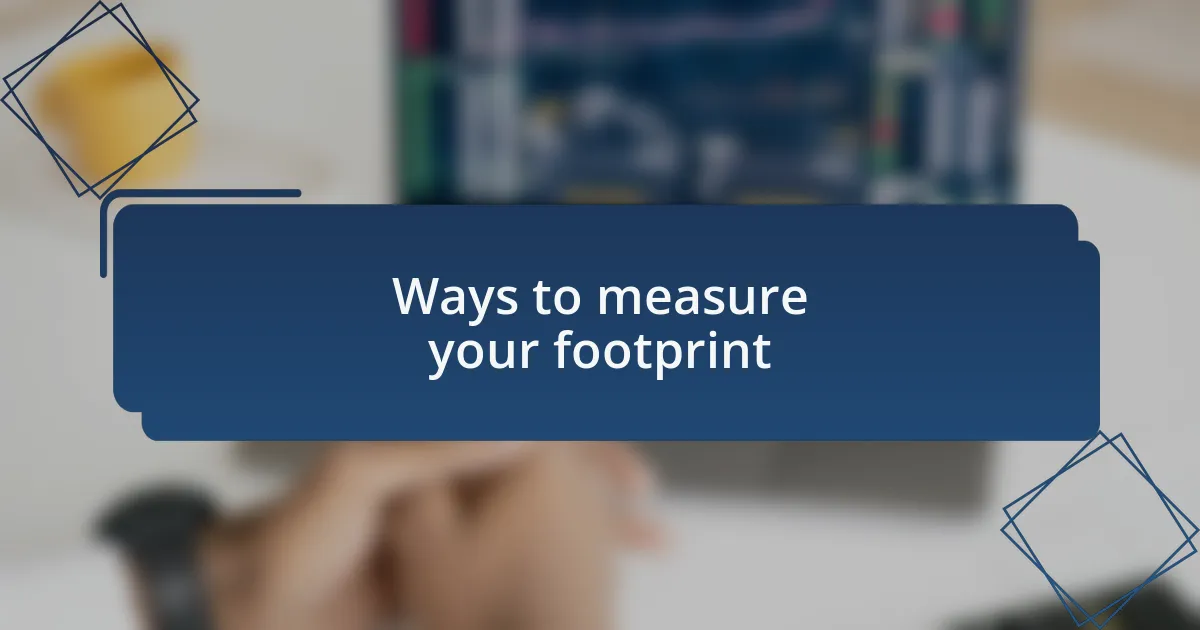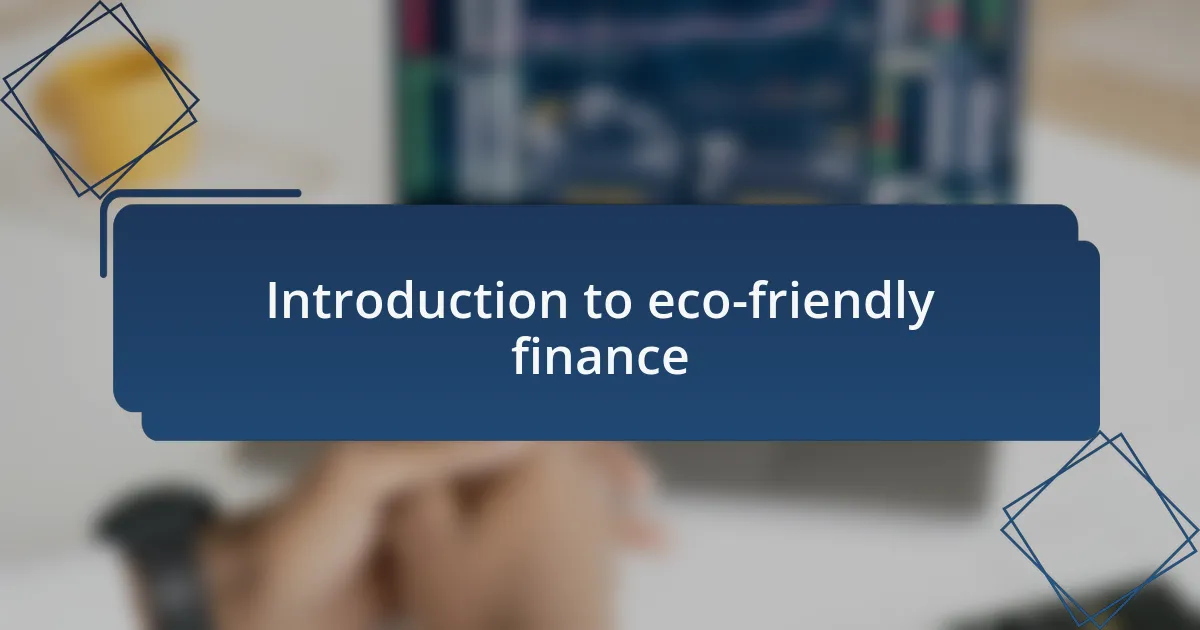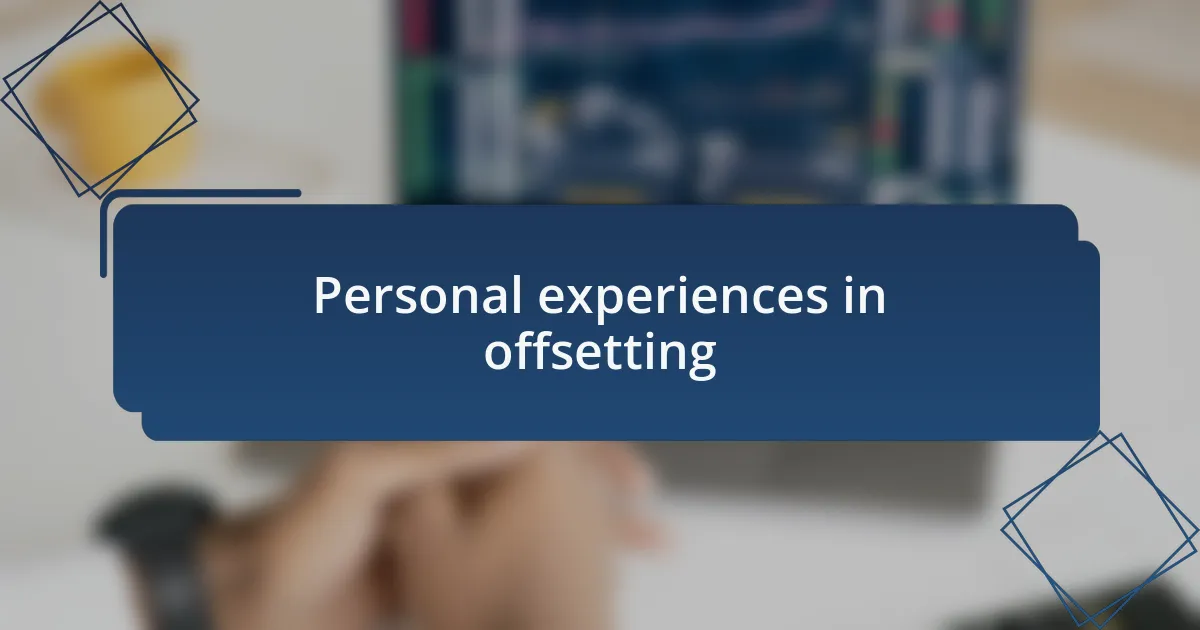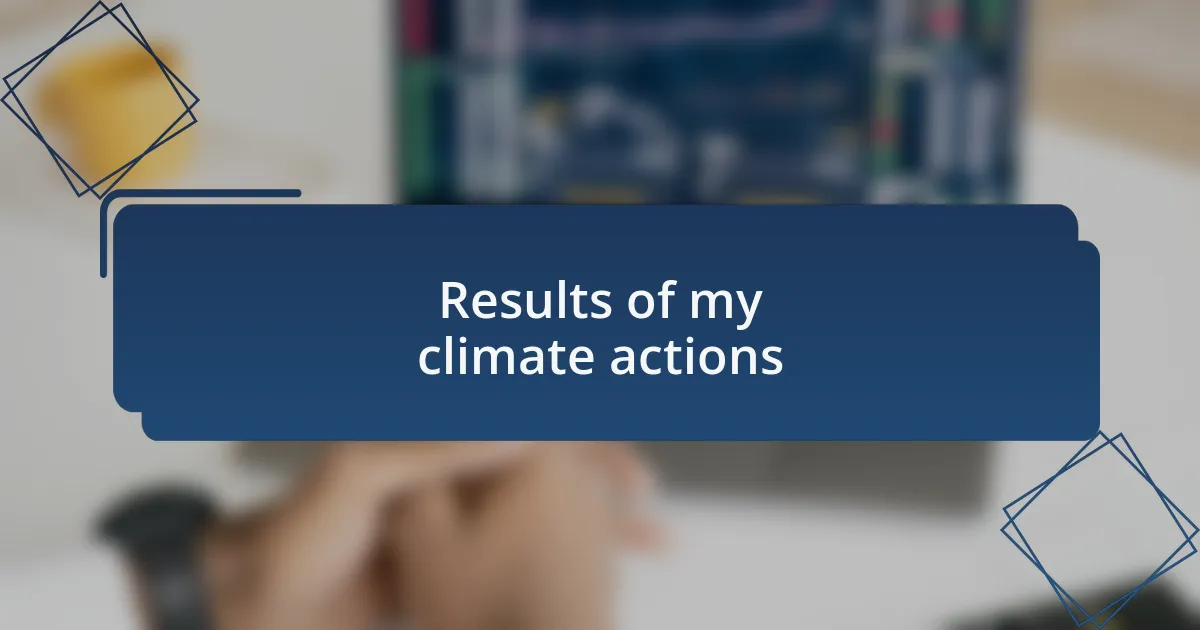Key takeaways:
- Understanding and measuring carbon footprints clarifies individual environmental impacts and encourages mindful choices.
- Carbon offsetting is vital for balancing personal emissions and supports broader sustainability efforts, empowering individuals to contribute positively.
- Engagement in community projects and eco-friendly finance enhances awareness and increases collective impact on climate change.
- Small personal actions, such as using public transport and reducing waste, can significantly lower carbon footprints and inspire others.

Understanding carbon footprint
When I first learned about carbon footprints, it struck me how our everyday actions contribute to these invisible yet significant environmental impacts. It’s startling to think that everything from the food we eat to the energy we consume at home adds to our overall carbon footprint. Have you ever considered how a simple decision, like driving instead of biking, influences this critical measure?
The concept of a carbon footprint essentially quantifies the total greenhouse gas emissions, expressed in carbon dioxide equivalents, that arise from our activities. For instance, I was surprised to discover that my daily coffee habit had a larger environmental cost than I anticipated — from the farming practices to the transportation. Reflecting on this made me more mindful of my choices, like opting for locally sourced products whenever possible.
Understanding your carbon footprint can be a real eye-opener. It’s not just an abstract number; it represents our impact on the planet. Each time I check my carbon emissions using online calculators, I feel a mix of responsibility and motivation. How can we make a difference if we don’t understand where we stand?

Importance of carbon offsetting
Offsetting my carbon footprint has become an essential part of my sustainability journey. These efforts help counterbalance the inevitable emissions from my daily life, like travels or energy use. Does it truly make a difference? Personally, I believe it does—every small step counts in the broader fight against climate change.
The importance of carbon offsetting resonates with me particularly because it offers a tangible way to combat environmental damage. When I invest in carbon offset projects, I not only support renewable energy or reforestation but also contribute to communities that rely on these initiatives. It feels empowering to know that my choices can foster positive change and create a more sustainable future for all.
I find that carbon offsetting allows us to acknowledge our imperfections while striving for better. It’s like turning guilt into action; instead of feeling overwhelmed by my carbon footprint, I choose to take responsibility. Have you ever thought about how offsetting can transform your approach to sustainability? By actively participating in these initiatives, we become part of a collective effort that truly matters.

Ways to measure your footprint
Tracking your carbon footprint can feel daunting, but it’s much simpler than it seems. One effective way I measure mine is through online calculators, which assess various aspects of my lifestyle, such as energy consumption, travel habits, and dietary choices. I remember the first time I used one; I was surprised by the results and realized how my seemingly small choices added up.
Another method I’ve come to appreciate is keeping a journal of my daily activities and their environmental impacts. I write down my travel methods, energy usage, and even the products I purchase. This reflective practice not only provides insights into my habits but also fosters a stronger sense of accountability. Have you ever considered how logging your choices could reveal patterns you weren’t aware of?
Lastly, I find that analyzing personal utility bills helps me gauge my energy consumption effectively. By reviewing monthly usage and comparing it to previous periods, I can identify spikes and set goals for reductions. This approach is motivating; each time I notice a decrease, I feel a sense of accomplishment that fuels my commitment to sustainable living. What practices do you find effective in your journey of understanding your carbon footprint?

Introduction to eco-friendly finance
Eco-friendly finance is about aligning our financial choices with sustainable practices, ensuring our investments support a healthier planet. I’ve found that when I direct my funds toward green projects, such as renewable energy or sustainable agriculture, it amplifies my commitment to eco-conscious living. Have you ever thought about how your financial decisions can either harm or heal the environment?
As I began to explore this concept, it became clear that eco-friendly finance isn’t just a personal endeavor; it’s a movement gaining momentum globally. I recall my experience attending a workshop on sustainable investing, where I learned how capital can be a powerful tool for positive change. It was eye-opening to see the potential impact of directing money into firms that prioritize sustainability, transforming traditional notions of profit and responsibility.
Moreover, eco-friendly finance encourages transparency and accountability in our financial systems. When I research companies for investment, I pay close attention to their environmental, social, and governance (ESG) practices. This level of scrutiny not only empowers me as a consumer but also fosters a deeper connection to my investments. What about you? How do you evaluate the sustainability of the businesses you support?

Steps to offset your emissions
Once I understood the significance of my carbon footprint, I took several practical steps to offset my emissions. Starting with a personal audit, I calculated my annual carbon output, focusing on areas like transportation and energy consumption. Have you ever tracked your daily habits? This exercise allowed me to identify key changes I could make, such as reducing car travel and opting for public transportation more often.
One effective way I found to offset my emissions is by investing in tree planting initiatives. I specifically chose a reputable organization that plants trees in deforested areas, and I commit to a small monthly donation. Witnessing the growth of these trees gave me a sense of involvement that was deeply rewarding. How about considering ways in which you can contribute similarly?
Additionally, I opted to support renewable energy projects in my community, which brings me satisfaction knowing I’m part of something larger. I started buying green energy credits which, while a small financial commitment, serve as a tangible reminder of my responsibility towards the planet. What actions have you thought about taking to make a meaningful impact?

Personal experiences in offsetting
One experience that stands out in my journey of offsetting my carbon footprint was when I decided to join a local community garden project. It wasn’t just about growing my own vegetables; it transformed my understanding of sustainable agriculture. I was amazed at how much carbon can be sequestered by healthy plants. Have you ever felt that connection to the earth while tending to a garden? That sense of nurturing was incredibly fulfilling; it lit a fire within me for not only offsetting my own emissions but also helping others learn about the importance of local food sources.
Another step I took was to evaluate my waste habits. I remember the eye-opening moment when I realized how much single-use plastic I was contributing to landfills. By shifting to reusable containers and shopping from bulk bins, I noticed a significant reduction in my waste footprint. Have you ever considered how small changes in your daily routine can have a ripple effect? The satisfaction of knowing I’m reducing waste not only alleviates my guilt about carbon emissions but has also inspired those around me to make similar changes.
Lastly, I became more conscious of my travel habits. A memorable trip I took involved biking instead of driving a short distance. It was an exhilarating experience that reminded me of the joys of low-impact travel. People often overlook how much carbon emissions come from short trips. What if more of us chose to cycle or walk instead? The fresh air, coupled with the knowledge that I was reducing my footprint, was refreshing and invigorating. I’d encourage you to reflect on your travel choices—every small decision counts.

Results of my climate actions
One of the most rewarding results of my climate actions has been the tangible decrease in my personal carbon footprint. After I committed to using public transportation instead of my car, I tracked my emissions and was pleasantly surprised by the numbers. Did you know that using mass transit can cut your carbon emissions significantly? Each time I stepped onto a bus or train, it felt like I was actively participating in a larger solution.
Another positive change emerged from my decision to support renewable energy sources. I opted to purchase green energy for my home, and I couldn’t believe the difference it made—not just in my bills but in my perspective. Seeing my utility bill reflect a commitment to sustainability sparked a sense of pride within me. Isn’t it motivating to know that our individual choices can lead to collective change in energy consumption?
On a more personal note, I discovered the joy of sharing my journey with others. When I joined a local eco-group, I realized how our collective efforts amplify our impact. I remember vividly the day we planted trees in a nearby park. Watching those seedlings take root symbolized hope for the future. Have you felt that rush of motivation when working alongside others for a common cause? Engaging with like-minded individuals has not only driven me to take more action but has also built a sense of community that strengthens our resolve.